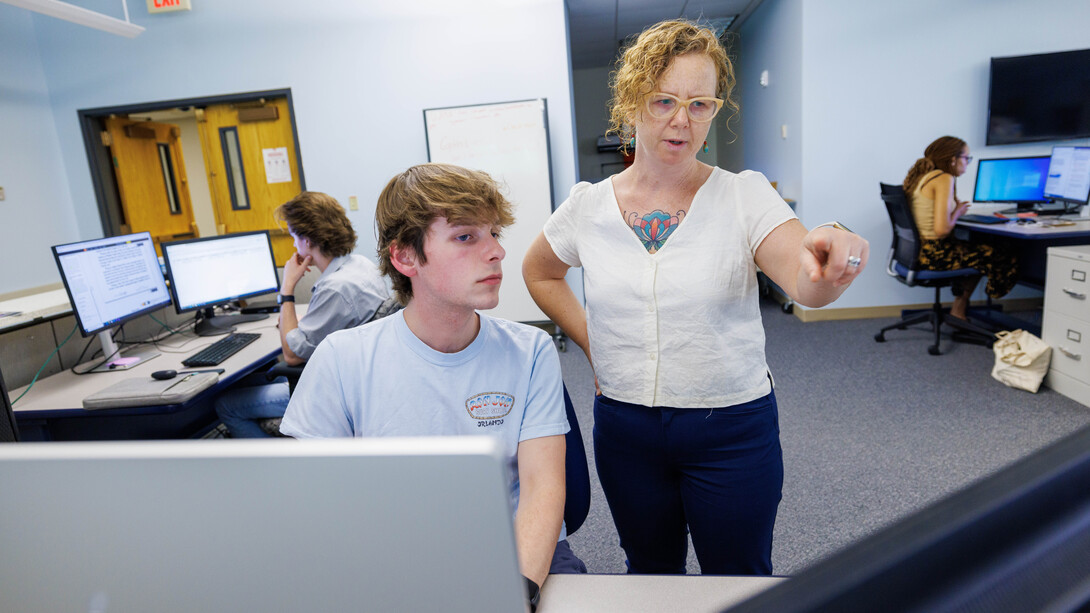
An extensive drone-based investigation of severe storms will be launched in coming weeks by the University of Nebraska–Lincoln, Texas Tech University, the University of Colorado Boulder, and the NOAA’s National Severe Storms Laboratory.
More than 50 scientists and students are making final preparations for the May 15 start. Fieldwork for the project will continue until June 16 and will cover a 367,000-square-mile area of the Great Plains from North Dakota to Texas, Iowa to Wyoming and Colorado.
“If there’s a supercell thunderstorm anywhere in the region, we hope to be there,” said Adam Houston, associate professor of atmospheric science at Nebraska and lead investigator.
Houston said the Targeted Observation by Radars and UAS of Supercells (TORUS) project is the largest-ever study of its kind based on the geographical area covered and the number of drones to be deployed (four).
The goal is to collect data to improve the conceptual model of supercell thunderstorms, the parent storms of the most destructive tornadoes. Scientists want to reduce the number of false-alarm tornado warnings and improve detection of the potentially lethal storms.
Stories on the TORUS project appeared in 10 Nebraska media outlets, including the Lincoln Journal Star, and more than 30 others across the country, including UAS Magazine and Unmanned Aerial Online.
- - -
Oxfam America included Chigozie Obioma’s second novel, “An Orchestra of Minorities,” in its annual list of books that illustrate the injustice of poverty. Obioma is an assistant professor of English at Nebraska.
Obioma recently contributed an essay on America to the anthology “The Good Immigrant USA.” The collection was included in a recommended-books list March 2 on Stylist. Obioma was mentioned in the article.
The play “The Fishermen” is coming to Trafalgar Studios in London’s West End. The play is based on the celebrated novel of the same name by Obioma. Broadway World published an article on the play’s move March 25.
Obioma discussed “An Orchestra of Minorities,” his writing process and career in a March 26 article in The Nation. He also discussed the novel in an interview with Nigeria’s PM News that published March 27.
- - -
Philip Schwadel, sociology, and a senior researcher focusing on religion at the Pew Research Center, wrote a March 6 Fact Tank post discussing how Americans’ drinking habits vary by faith. He noted that religiously active people are less likely to drink alcohol than those who are not as religious. Among U.S. Christians, Catholics are more likely than Protestants to drink alcohol. Rates and views on drinking also vary among religious and nonreligious subgroups, he wrote, and by other demographics besides religion.
- - -
A pioneering study from Annabel Olson, doctoral student in biological sciences, and colleagues shows that losing a gene can improve evolutionary fitness. The team discovered the surprise after deleting the so-called B1 gene, critical to replication, from the vaccinia virus — which is best known for immunizing humanity against smallpox. The virus responded by deleting another gene — and regained its ability to replicate. Phys.org ran an article on the research March 11.
- - -
Bedross Der Mattossian, history, and author of the book “Shattered Dreams of Revolution: From Liberty to Violence in the Late Ottoman Empire,” was quoted in a March 11 Newsweek article on Turkish President Recep Tayyip Erdogan tweeting in Armenian for the first time. Erdogan’s tweet expressed condolences after the death of Armenian Patriarch Mesrob Mutafyan. Der Mattossian said he thought the tweet was aimed at influencing the election for a new patriarch.
- - -
John Hibbing and Kevin Smith, political science, were cited in a March 13 New York Times opinion piece on partisan hostility increasing in the United States.
Hibbing was also interviewed for a March 25 Pacific Standard article on whether Robert Mueller’s report on Russian interference in the 2016 election would change anyone’s views. He said he assumed reactions to the report would follow patterns of motivated reasoning, which allows people who are especially attuned to politics to reject any information that does not fit their views.
- - -
Kwame Dawes, English, has won a prestigious Windham-Campbell Prize. Dawes is the author of 20 books of poetry and numerous other works of fiction and nonfiction. Stories on the prize win appeared in 12 Nebraska media outlets, including the Omaha World-Herald; The Guardian; Los Angeles Times; USA Today; and several other media outlets.
- - -
Ken Dewey, geography, and a regional climatologist, was interviewed for a March 18 Forbes article on the “bomb cyclone” that has caused widespread flooding in the Great Plains.
- - -
A new study by researchers at the University of Missouri and University of Nebraska–Lincoln has found that men often use five metaphors — “lost gift,” “cataclysm” “death of a loved one,” “emptiness” and “chaotic movement” — to describe the physical, emotional and relational implications of their partner’s miscarriage. The research expands upon a communication model created by Haley Kranstuber Horstman, professor of communication at Missouri, and Jody Koenig Kellas, communication studies. Stories on the research appeared in Futurity and a few other media outlets.
- - -
A 2012 study by University of Nebraska–Lincoln researchers was cited in a March 26 Psychology Today article on how anxiety warps one’s perception. The study found that people who pay more attention to aversive images tend to be more conservative politically.
- - -
David Hage, chemistry, was involved with recent research showing how the body transports testosterone and explaining why patients on certain medications have low levels of the hormone. Stories on the research appeared in WCAV/WVAW/WAHU in Charlottesville, Virginia, and a few other media outlets.
- - -
Heather Richards-Rissetto, anthropology, was interviewed for a March 28 NBCNews.com story on scientists using ground-penetrating radar to find remnants of a mid-1800s military installation below the recreation yard of the defunct Alcatraz Federal Penitentiary on Alcatraz Island. Richards-Rissetto, who uses lidar and photogrammetry in her research, discussed how technology is transforming archaeology.


